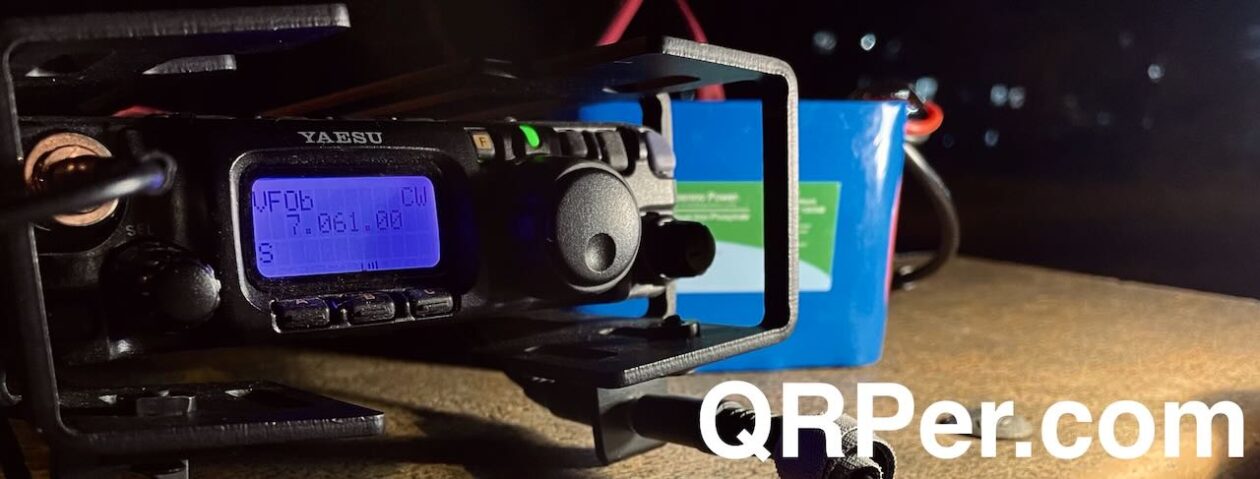My friend Jonathan (KM4CFT) recently sent me a neat little prototype paddle he designed for the Elecraft KX2 and KX3 field transceivers.
He wanted my feedback, so he generously sent me a set to evaluate at no charge.
 Lately, I’ve been tied up with the final stages of debris cleanup here at the QTH, leaving little time for field activations. While I haven’t had the chance to take these paddles out into the field yet (stay tuned!) I’ve thoroughly tested them on both my Elecraft KX3 and KX2. In the meantime, Jonathan has made the kits available for purchase on the HamGadgets website.
Lately, I’ve been tied up with the final stages of debris cleanup here at the QTH, leaving little time for field activations. While I haven’t had the chance to take these paddles out into the field yet (stay tuned!) I’ve thoroughly tested them on both my Elecraft KX3 and KX2. In the meantime, Jonathan has made the kits available for purchase on the HamGadgets website.
The price? $49.97 — a solid deal for a simple, functional paddle designed to plug directly into the front of the KX2 and KX3.
 Assembly is quick and straightforward, taking around 15-20 minutes. There aren’t many parts, and the mechanics are refreshingly simple. If you’re curious, you can check out the kit assembly manual here (PDF).
Assembly is quick and straightforward, taking around 15-20 minutes. There aren’t many parts, and the mechanics are refreshingly simple. If you’re curious, you can check out the kit assembly manual here (PDF).
My Impressions
 I think it’s an excellent little key for the price. The paddle action is light — the 3D printed material keeps them featherweight, making keying effortless.
I think it’s an excellent little key for the price. The paddle action is light — the 3D printed material keeps them featherweight, making keying effortless.
For field use, they should perform brilliantly. The light touch required keeps things stable on a table, with the KX2 or KX3 providing more than enough weight to prevent the paddles from shifting as you operate.
 The operating angle works well for me too. I know Jonathan put a lot of time into getting this right during the design process — and it shows.
The operating angle works well for me too. I know Jonathan put a lot of time into getting this right during the design process — and it shows.
Any Downsides?
The biggest drawback, in my opinion, is that the two thumbscrews securing the paddles to the front of the radio aren’t captive.
 This means they can be easily lost during transport. I recommend storing the paddles in a thick poly bag to keep everything together in your pack.
This means they can be easily lost during transport. I recommend storing the paddles in a thick poly bag to keep everything together in your pack.
Additionally, because the screws aren’t captive, you need to be a little careful when installing the paddle. I’ve found it easiest to place the radio on its back, so you’re screwing the thumbscrews downward.
 I lightly plug in the paddle, then start threading both screws before fully tightening either one. This gives me better control and helps avoid dropping the screws — something that could be a real headache in the field, especially if they hit the ground.
I lightly plug in the paddle, then start threading both screws before fully tightening either one. This gives me better control and helps avoid dropping the screws — something that could be a real headache in the field, especially if they hit the ground.
 Lastly, these paddles don’t have the “precision key” feel of more expensive options. But to be fair, they’re designed as an affordable alternative to Elecraft’s KXPD2 paddles, which retail for $169.95. Even the KXPD2 — while smaller and sturdier — doesn’t feel particularly “precision” in use. The KX3 paddles come closer to that, but they also cost $239.95.
Lastly, these paddles don’t have the “precision key” feel of more expensive options. But to be fair, they’re designed as an affordable alternative to Elecraft’s KXPD2 paddles, which retail for $169.95. Even the KXPD2 — while smaller and sturdier — doesn’t feel particularly “precision” in use. The KX3 paddles come closer to that, but they also cost $239.95.
 At $49.95, it’s hard to complain — these paddles do exactly what they’re supposed to do without breaking the bank!
At $49.95, it’s hard to complain — these paddles do exactly what they’re supposed to do without breaking the bank!
 If you’ve held off buying front-mounted paddles for your KX2 or KX3 because of the cost, I’d highly recommend giving these KM4CFT paddles a try.
If you’ve held off buying front-mounted paddles for your KX2 or KX3 because of the cost, I’d highly recommend giving these KM4CFT paddles a try.
Click here to check out the KM4CFT KX2/KX3 paddles on HamGadgets.





































